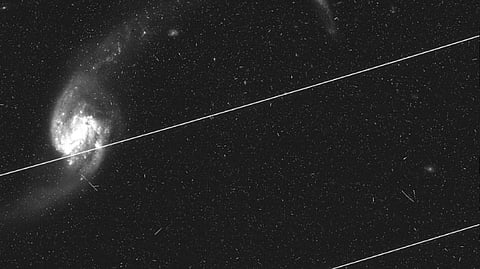

Shannon Hall
The Hubble Space Telescope, known for recording awe-inspiring images of the cosmos while advancing the field of astronomy, is under threat. Private companies are launching thousands of satellites that are photobombing the telescope — producing long bright streaks and curves of light that can be impossible to remove. And the problem is only getting worse.
A study, published Thursday in the journal Nature Astronomy, reveals an increase in the percentage of images recorded by the Hubble that are spoiled by passing satellites. And the data goes only through 2021. Thousands more satellites have been launched since then by SpaceX and other companies, and many more are expected to go to orbit in the years ahead, affecting the Hubble and potentially other telescopes in space.
“We’re going to be living with this problem. And astronomy will be impacted,” said Jonathan McDowell, an astronomer at the Harvard-Smithsonian Center for Astrophysics who was not involved in the study. “There will be science that can’t be done. There will be science that’s significantly more expensive to do. There will be things that we miss.”
The Hubble Space Telescope’s legacy cannot be overstated. Because of the observatory, we now know, for example, that the universe is 13.8 billion years old, that most galaxies contain a supermassive black hole at their centers and that stars form in violent processes. The Hubble’s images — including the gorgeous clouds of gas and dust in the “pillars of creation” and the view of nearly 10,000 galaxies in the “Hubble ultra deep field” — never fail to inspire.
But the number of satellites in orbit has significantly increased since the Hubble launched in 1990, and now it is staring at the cosmos through a field of satellites.
In response, Elon Musk, SpaceX’s founder and chief executive, suggested that astronomers bypass the issue by moving telescopes to orbit.
But Hubble, which lives in low-Earth orbit roughly 335 miles above Earth’s surface, actually resides less than 10 miles below most Starlink satellites. That means that the observatory and other orbital space telescopes are still facing interference from satellite constellations. “Not only do you have to put your telescopes in space, but you also have to put them above all the other traffic,” Dr. McDowell said.
“I think we’ll be forced to do that in the decades to come,” he said. But that isn’t possible for current telescopes in low-Earth orbit or spacecraft that governments are building and launching in the coming years.
To quantify the effect of satellite constellations on Hubble, Sandor Kruk, an astronomer at the Max Planck Institute for Extraterrestrial Physics in Germany, and his colleagues analysed an archive of images taken from 2002 through 2021.
They had help from hundreds of citizen scientists who pored through images to tag those with clear satellite streaks.
Mark McCaughrean, an astronomer at the European Space Agency and a co-author on the new study, is confident in their analysis, but notes that this is only a minor issue at the moment. Typically, Hubble takes multiple images that are stacked on top of one another — a technique that will erase any satellites.
Hall is a journalist with NYT©2023
The New York Times
Visit news.dtnext.in to explore our interactive epaper!
Download the DT Next app for more exciting features!
Click here for iOS
Click here for Android